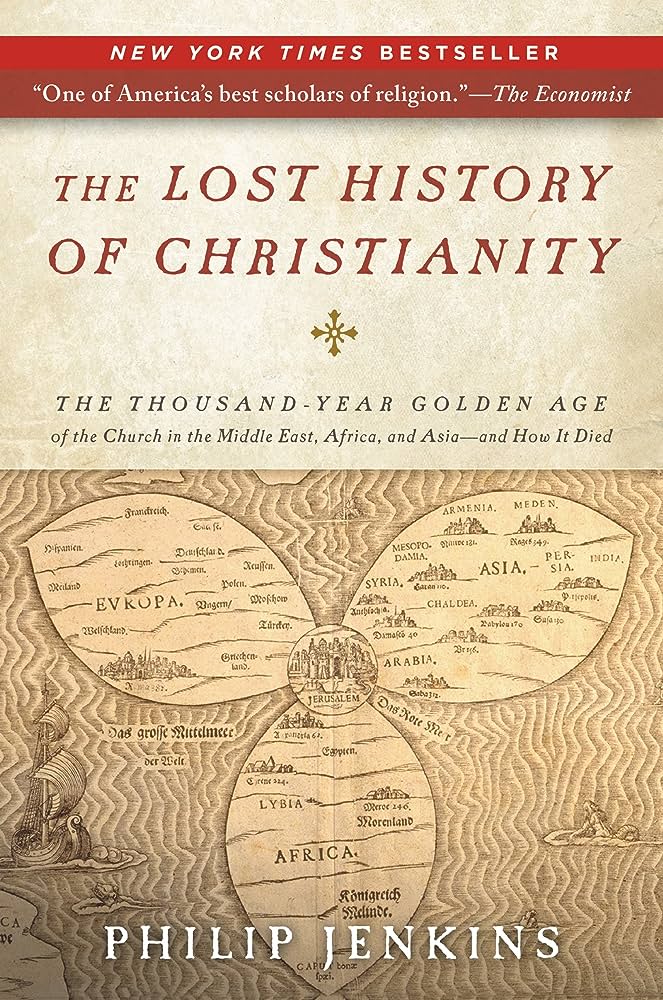Sean Bala reviewed The Lost History of Christianity by Philip Jenkins
Review of 'The lost history of Christianity' on 'Goodreads'
3 stars
“The Lost History of Christianity” by Philip Jenkins is a book that has popped up in my historical research quite a bit. It has been cited as one of the most accessible introductions to a whole hidden corner of Christian (and Global) history: the vast Christian community in Asia from the time of the Apostles to the 1300s, when they began to disappear through a mixture of persecution, loss of community space, and climate change. But the book is more interesting than its title suggests and it’s a profoundly insightful examination of a little explored corner of religious studies: how do religions die? And do they die completely.
The book is written for a popular audience and reads quite easily. The book could be roughly divided into three parts. First is establishing the historical record of the presence of Christian communities in whole of Asia. These Churches belonged to what …
“The Lost History of Christianity” by Philip Jenkins is a book that has popped up in my historical research quite a bit. It has been cited as one of the most accessible introductions to a whole hidden corner of Christian (and Global) history: the vast Christian community in Asia from the time of the Apostles to the 1300s, when they began to disappear through a mixture of persecution, loss of community space, and climate change. But the book is more interesting than its title suggests and it’s a profoundly insightful examination of a little explored corner of religious studies: how do religions die? And do they die completely.
The book is written for a popular audience and reads quite easily. The book could be roughly divided into three parts. First is establishing the historical record of the presence of Christian communities in whole of Asia. These Churches belonged to what is now known as the Oriental Orthodox Churches, which split from the rest of the Christian world over the Council of Chalcedon (which defined Jesus has having two natures—human and divine). Or perhaps better stated, the book looks at the area where the vast majority of Christians resided and ignores the group of European Christians in Rome and Constantinople that broke away from the Christian majority. So much of this time is spent emphasizing that this as a vast network with a rich tradition that is totally unknown in the West. In fact, this is where I think the book is weakest—he spends so much time trying to emphasize the scope of the community that he does not talk much about their beliefs or what made them distinct. The fact that they existed is enough for him.
The second part of the book looks at the destruction of the communities and shows how they were eventually destroyed through successive waves of invasions from Mongols, the growing vicious crackdown on Christianity by Islam, changing environmental conditions which put more pressure on societies across the world in the late 1200s and 1300s, and European meddling in the Middle East which led many Muslims to associate these Christians communities (which pre-date Islam) with foreign invaders. Jenkins is willing to put forward a balanced account that is willing to say things that may not be acceptable by commentators. On one hand, he argues that we cannot simply say that Islam as violent or inherently oppressive. All religions can be oppressive. All can be oppressed. Islam share a deeply rich connection with Christianity. Muslim rulers were overall willing to allow Christianity to continue to be practiced. But on the other hand, we cannot ignore the fact that many Muslim rulers in the Middle Ages did persecute Christianity and made it more difficult for Christians to practice. There was violence, massacres, genocides, and humiliating restrictions placed on non-Muslims in the Muslim world. This pattern was also seen outside of the Muslim world in places like China and Japan. To ignore either legacy is to try to read contemporary debates into the past and to shape the historical narrative to fit modern sensibilities. This willingness to push both sides of the debate is one of the strengths of Jenkin’s work.
The book is strongest when dealing with the broader existential questions of how religions die and survive. This makes the book useful as a theoretical text on the sociology of religion. His deeper point is to get his audience (which I assume that he assumes are Western Christians - a weakness you often find in books on religion for a popular audience) to understand that nothing is inevitable. While the fortunes of one religion may be in ascendant, in the grand scheme of history it is just as likely for that one religion is to be replaced by another. The virtual disappearance of Christianity from the Middle East is tragic. It is the loss of one of the last remaining links of global Christianity to its roots. The analogy he uses to describe the situation of Christianity today is to say that is as if “Islam was extinguished in Arabia and the Middle East and survived chiefly in Southeast Asia, using scriptures translated in Malay and Bengali” (26). But the work gives the reader an honest exploration of how communities might survive and change in the face of pressures internally and externally. The book is worth reading both for people interested in Christianity but also for people interested in history, religions, and historical change.

